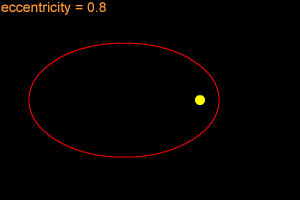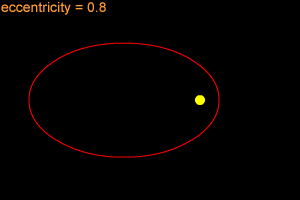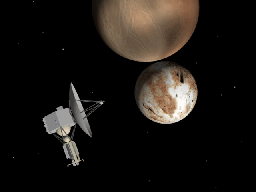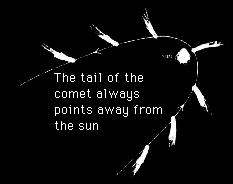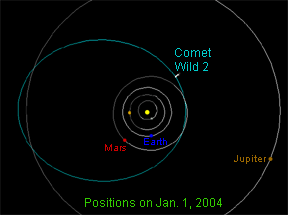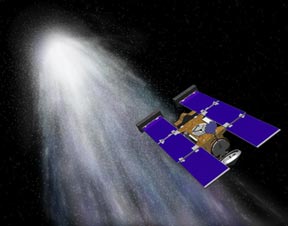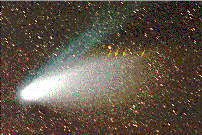Orbit Shapes Interactive Animation
This interactive animation illustrates two of the most important parameters associated with orbits - shape and size. Orbits are ellipses. Mathematicians and astronomers use the term "eccentricity" to describe how elongated (oval-shaped, as opposed to circular) an ellipse is. A high eccentricity means an ellipse is long and skinny; a low value means the ellipse is nearly circular. For an ellipse, eccentricity can range from zero to one.
Astronomers use the term "semi-major axis" length to describe the size of an ellipse. The major axis of an ellipse runs lengthwise along the long axis of the ellipse. The semi-major axis length is the distance from the center of the ellipse to one end along this major axis. The semi-major axis of an ellipse is analogous to the radius of a circle.
Use the sliders in the interactive animation (below) to alter the shape and size of the orbit of "your planet". Earth's orbit is shown for comparison.
(Note: If you cannot see the animation below, or it is not working properly, you may need to download the latest Flash player.)
An astronomical unit (AU) is the length of the semi-major axis of Earth's orbit. It is commonly used to refer to distances within our Solar System.
Notice how a planet with an elliptical orbit moves closer to and further away from the Sun. The point of closest approach to the Sun is called perihelion. The furthest point is called aphelion.
Johannes Kepler, a German astronomer who lived in the early 17th century, discovered three important laws about planetary orbits.
Activities
Here are a few activities you may want to try, using the orbit shapes interactive, to learn more about orbits:
- A "Hohman transfer ellipse" is a trajectory commonly used to send a spacecraft between two planets that have circular orbits. The orbits of Earth and Jupiter are very nearly circular. Pretend "your planet" in the interactive is a spacecraft being sent from Earth to Jupiter. Adjust its eccentricity and semi-major axis until its perihelion point is just touching Earth's orbit and its aphelion point is just reaching out to Jupiter's orbit. About how long does it take a spacecraft on this trajectory to travel to Jupiter? Note the position of Earth when the "spacecraft" reaches perihelion; then count how many times Earth circles the Sun while the "spacecraft" travels to Jupiter. Remember, each time the Earth goes around is one year!
- As you probably know, Pluto orbits further from the Sun than any of the other eight planets. You may not know that Pluto's orbit is also more eccentric than the orbits of the other eight planets. The orbit of Pluto has an eccentricity around 0.25 and a semi-major axis length of about 39.5 AU. Set the values for "your planet" in the interactive animation to those of Pluto. How does the orbit of Pluto compare to the orbit of Neptune, the 8th planet in order from the Sun? Is Pluto always the most distant planet from the Sun? If not, how much of the time is it closer to the Sun than another planet? How does the relatively high eccentricity of Pluto's orbit influence this situation? If Pluto's orbit was less eccentric, would it ever be the 8th planet?
- Most comets have very eccentric orbits. The most famous comet, Halley's Comet, has an orbital eccentricity of 0.967 and a semi-major axis length of almost 18 AU. This interactive animation only allows eccentricity settings up to 0.9; check out the comet orbit interactive to see what Halley's orbit looks like. Some comets, called short period comets because they orbit the Sun in less than 200 years, come from a region beyond Neptune's orbit called the Kuiper Belt. A typical short period comet might have an eccentricity around 0.9 and a semi-major axis length of about 25 AU. Try out those values in the interactive animation on this page. Where does a short-period comet spend most of its time? A comet only forms its tails and becomes visible to us when it is close to the Sun, well inside the orbit of Jupiter. Notice how a comet is only visible for a few months out of an orbit lasting decades to centuries (Halley's Comet takes 76 years to orbit the Sun). Some comets have much shorter orbital periods of just a few years. Many of these are "Jupiter-family comets" that were tossed into the inner Solar System by the gravity of that giant planet during a close encounter with Jupiter. Comet Wild 2, the target of the Stardust space mission, is one such Jupiter-family comet. Wild 2 has an eccentricity of 0.54, a semi-major axis length of 3.44 AU, and an orbital period of 6.39 years. Set up Wild 2's orbit in the interactive animation to see a typical Jupiter-family comet. Finally, some comets come from the far distant reaches of the Oort Cloud, the outermost fringe of our Solar System. One such "long-period comet", Comet Hale-Bopp, has an eccentricity of 0.995 and a semi-major axis length of about 186 AU! Hale-Bopp put on a spectacular show in 1997, but won't be back this way again for more than 2,500 years!






